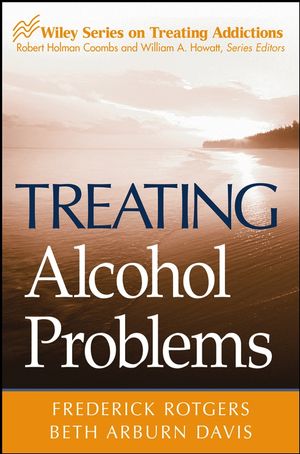Treating Alcohol ProblemsISBN: 978-0-471-49432-4
Paperback
176 pages
April 2006
 This is a Print-on-Demand title. It will be printed specifically to fill your order. Please allow an additional 10-15 days delivery time. The book is not returnable.
|
||||||
Preface.
Chapter 1: Conceptual Foundations:Defining Alcohol Problems.
Alcohol Problems: What Are They, Who’s Got Them, Who Hasn’t, Who Might?
Defining Alcohol Problems.
Drinking Definitions.
Diagnosis Definitions.
ASAM Definition of Alcoholism.
Abusing “Abuse”.
How the DSM Works.
Alcohol Abuse.
Alcohol Dependence.
Once a Drunk, Always a Drunk? The Course of Alcohol Problems.
Treat Me or Lose Me: Is Treatment Necessary to Resolve Alcohol Problems?
To Quit or Not? How Do Most People Resolve Alcohol Problems?
Different Strokes for Different Folks: Recovery, Relapse, and the Future of Treatment.
Key Terms.
Recommended Reading.
Chapter 2: Identifying Alcohol Problems: “I Know It When I See It! Or Do I?”
Signs and Symptoms: Fleshing Out the DSM.
The Case of Mary.
The Case of Tom.
Recognizing More than One Problem: Is It Just a Drinking Problem?
How Likely Is the Problem Drinker to Have Other Problems?
“Denial” May Be Just Another River in Egypt: Where Does Denial Come From?
What Should I Do as a Professional? Roles and Responsibilities.
How Drinking Affects Family, Work, and Other Areas of the Client’s Life.
Family and Social Problems.
Work Problems.
Health and Medical Consequences.
“So What’s In It For Me?” Answering Questions from Clients about Treatment.
To Refer or Not to Refer: Advantages and Disadvantages of Referring a Client to Specialized Treatment.
Summing Up.
Key Terms.
Chapter 3: Finding and Getting the Best Out of Professional Resources.
Developing a Professional Referral Network.
The “Match” Game: How to Select the Right Professional.
The Role of Medical Personnel.
The Client with Mental Health and Alcohol Use Problems.
Finding Out about the Professional’s Style and Method of Practice.
Referrals for Adolescents.
Referrals for Older Persons.
Diversity and Referrals.
Spirituality and Religion in the Referral Process.
Clients’ Sexual Orientation and the Referral Process.
The Suicidal or Homicidal Client: Protection and Duty to Warn.
Helping the Client to Consider Treatment ... or Motivation, Motivation, Motivation.
Crises.
When a Crisis is in Progress.
The Dangerous Situation.
Involving Friends and Family.
Risk Management Strategies.
Risk Management: Protection for You and Your Client.
Referral Follow-Up.
Key Terms.
Recommended Reading.
Chapter 4: Assessment and Treatment Planning.
Treatment Plan as the Map to Success.
The Beginning of It All: The Intake.
The Big Picture: The Genogram.
Insurance.
Screening Evaluation or Assessment Battery?
Family, Friends, and Concerned Others in the Treatment Planning Process.
Self-Harm and Harm to Others: Initial and Ongoing Assessment.
Summing Up.
Key Terms.
Recommended Reading.
Chapter 5: Treatment Tools, Programs, and Theories: Helping
Clients Overcome Problem Drinking.
Change Tools: What’s Available to Help People Overcome Drinking Problems and How Effective are Various Approaches?
Readiness for Change as the Therapeutic “Wild Card”.
What’s the Best Approach?
Twelve-Step Approaches.
Cognitive Behavioral Treatments (CBT).
Motivational Interviewing (MI).
Inpatient or Outpatient: Which is Best?
Medication.
The Role of Support Groups in Helping Clients Overcome Alcohol Problems.
Self-Selection and Choice.
Drinking Goal.
Belief or Disbelief in Disease Model Accounts of Alcohol Problems.
Comorbid Psychopathology.
Availability.
Summing Up.
Key Terms.
Recommended Reading.
Chapter 6: When and How Should Clients Be Discharged to Aftercare?
What is Aftercare?
How Do You Know If the Client Should be Discharged to Aftercare?
Types of Aftercare.
Halfway Houses.
Partial Hospitalization or Intensive Outpatient Treatment.
Outpatient Aftercare.
Discharge from Aftercare.
Aftercare for the Client with Dual Diagnosis.
Assessing Community Resources.
Family and Friends in the Aftercare Setting.
Key Terms.
Recommended Reading.
Chapter 7: How to Increase Recovery Success, Minimize “Slips,” and Avoid Chronic Relapse.
The Problem of the “Failure” Label.
Lapse and Relapse.
Assessing Relapse Potential.
What Is Relapse Prevention?
Fostering Hope and Self-Efficacy.
Relapse Prevention 101.
How the “Thinking” Factor Works.
Enhancing Self-Efficacy: The Power of Accurate Thinking.
Triggers: People, Places, Things, and More.
Developing a Relapse Prevention Plan.
Dealing with Cravings and Urges.
Steps in Creating a Relapse Prevention Plan.
Monitoring Progress.
Working the Relapse Prevention Plan.
Key Terms.
Recommended Reading.
Chapter 8: Culture, Coaching, and Change: Moving Beyond Alcohol Problems.
Culture and Ethnicity in Changing Alcohol Problems: Different Strokes for Different Folks.
Defining and Maintaining a Healthy Lifestyle.
Summing Up.
Key Terms.
Recommended Reading.
Appendix A: Locating and Selecting Treatment Programs for
Referrals.
Appendix B: Biological Monitoring and Effective Treatment.
References.
Index.



